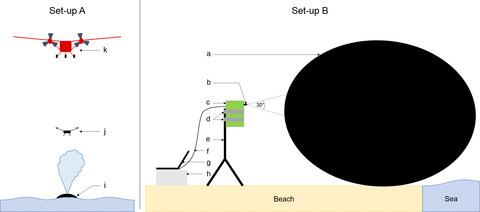当前位置:
X-MOL 学术
›
Remote Sens. Ecol. Conserv.
›
论文详情
Our official English website, www.x-mol.net, welcomes your feedback! (Note: you will need to create a separate account there.)
Spectral reflectance of whale skin above the sea surface: a proposed measurement protocol
Remote Sensing in Ecology and Conservation ( IF 5.5 ) Pub Date : 2020-03-10 , DOI: 10.1002/rse2.155 Hannah C. Cubaynes 1, 2 , W. Gareth Rees 2 , Jennifer A. Jackson 1 , Michael Moore 3 , Todd L. Sformo 4, 5 , William A. McLellan 6 , Misty E. Niemeyer 7 , John C. George 4 , Julie Hoop 3, 8 , Jaume Forcada 1 , Phil Trathan 1 , Peter T. Fretwell 1
Remote Sensing in Ecology and Conservation ( IF 5.5 ) Pub Date : 2020-03-10 , DOI: 10.1002/rse2.155 Hannah C. Cubaynes 1, 2 , W. Gareth Rees 2 , Jennifer A. Jackson 1 , Michael Moore 3 , Todd L. Sformo 4, 5 , William A. McLellan 6 , Misty E. Niemeyer 7 , John C. George 4 , Julie Hoop 3, 8 , Jaume Forcada 1 , Phil Trathan 1 , Peter T. Fretwell 1
Affiliation

|
Great whales have been detected using very‐high‐resolution satellite imagery, suggesting this technology could be used to monitor whales in remote areas. However, the application of this method to whale studies is at an early developmental stage and several technical factors need to be addressed, including capacity for species differentiation and the maximum depth of detection in the water column. Both require knowledge of the spectral reflectance of the various whale species just above the sea surface, as when whales bodies break the surface of the water to breath, log or breach, there is, at times, no sea water between the whale's skin and the satellite sensor. Here we tested whether such reflectance could be measured on dead whale tissue. We measured the spectral reflectance of fresh integument collected during the bowhead subsistence harvest, and of thawed integument samples from various species obtained following strandings and stored at −20°C. We show that fresh and thawed samples of whale integument have different spectral properties. The reflectance of fresh samples was higher than the reflectance of thawed samples, as integument appears to darken after death and with time, even under frozen conditions. In this study, we present the first whale reflectance estimates (without the influence of sea water and for dead tissue). These provide a baseline for additional work, needed to advance the use of satellite imagery to monitor whales and facilitate their conservation.
中文翻译:

海平面以上鲸鱼皮的光谱反射率:建议的测量方案
使用超高分辨率的卫星图像已检测到大鲸鱼,这表明该技术可用于监视偏远地区的鲸鱼。但是,该方法在鲸鱼研究中的应用尚处于发展的早期阶段,需要解决几个技术因素,包括物种分化能力和在水柱中的最大探测深度。两者都需要了解海面上方各种鲸鱼物种的光谱反射率,因为当鲸鱼身体破坏水面以呼吸,记录或破坏时,鲸鱼的皮肤和珊瑚之间有时没有海水。卫星传感器。在这里,我们测试了是否可以在死鲸组织上测量这种反射率。我们测量了在弓头维持生存收获期间收集的新鲜被膜的融化光谱光谱,以及在绞合后从各种物种中解冻并被储存在-20°C的融化的被膜样本的光谱反射率。我们表明,新鲜和融化的鲸鱼被膜样品具有不同的光谱特性。新鲜的样品的反射率高于解冻的样品的反射率,因为在死亡后甚至随着时间的推移,即使在冰冻的条件下,其外皮也会变黑。在这项研究中,我们提出了第一个鲸鱼反射率估计值(没有海水的影响和死组织的影响)。这些为开展更多工作提供了基准,这些工作是推进利用卫星图像监测鲸鱼并促进其养护所必需的。我们表明,新鲜和融化的鲸鱼被膜样品具有不同的光谱特性。新鲜的样品的反射率高于解冻的样品的反射率,因为在死亡后甚至随着时间的推移,即使在冰冻的条件下,其外皮也会变黑。在这项研究中,我们提出了第一个鲸鱼反射率估计值(没有海水的影响和死组织的影响)。这些为开展更多工作提供了基准,这些工作是推进利用卫星图像监测鲸鱼并促进其养护所必需的。我们表明,新鲜和融化的鲸鱼被膜样品具有不同的光谱特性。新鲜的样品的反射率高于解冻的样品的反射率,因为在死亡后甚至随着时间的推移,即使在冰冻的条件下,其外皮也会变黑。在这项研究中,我们提出了第一个鲸鱼反射率估计值(没有海水的影响和死组织的影响)。这些为开展更多工作提供了基准,这些工作是推进利用卫星图像监测鲸鱼并促进其养护所必需的。我们提出了第一个鲸鱼反射率估计值(没有海水的影响和死组织的影响)。这些为进一步利用卫星图像来监测鲸鱼并促进其保护提供了基础。我们提出了第一个鲸鱼反射率估计值(没有海水的影响和死者组织的影响)。这些为开展更多工作提供了基准,这些工作是推进利用卫星图像监测鲸鱼并促进其养护所必需的。
更新日期:2020-03-10
中文翻译:

海平面以上鲸鱼皮的光谱反射率:建议的测量方案
使用超高分辨率的卫星图像已检测到大鲸鱼,这表明该技术可用于监视偏远地区的鲸鱼。但是,该方法在鲸鱼研究中的应用尚处于发展的早期阶段,需要解决几个技术因素,包括物种分化能力和在水柱中的最大探测深度。两者都需要了解海面上方各种鲸鱼物种的光谱反射率,因为当鲸鱼身体破坏水面以呼吸,记录或破坏时,鲸鱼的皮肤和珊瑚之间有时没有海水。卫星传感器。在这里,我们测试了是否可以在死鲸组织上测量这种反射率。我们测量了在弓头维持生存收获期间收集的新鲜被膜的融化光谱光谱,以及在绞合后从各种物种中解冻并被储存在-20°C的融化的被膜样本的光谱反射率。我们表明,新鲜和融化的鲸鱼被膜样品具有不同的光谱特性。新鲜的样品的反射率高于解冻的样品的反射率,因为在死亡后甚至随着时间的推移,即使在冰冻的条件下,其外皮也会变黑。在这项研究中,我们提出了第一个鲸鱼反射率估计值(没有海水的影响和死组织的影响)。这些为开展更多工作提供了基准,这些工作是推进利用卫星图像监测鲸鱼并促进其养护所必需的。我们表明,新鲜和融化的鲸鱼被膜样品具有不同的光谱特性。新鲜的样品的反射率高于解冻的样品的反射率,因为在死亡后甚至随着时间的推移,即使在冰冻的条件下,其外皮也会变黑。在这项研究中,我们提出了第一个鲸鱼反射率估计值(没有海水的影响和死组织的影响)。这些为开展更多工作提供了基准,这些工作是推进利用卫星图像监测鲸鱼并促进其养护所必需的。我们表明,新鲜和融化的鲸鱼被膜样品具有不同的光谱特性。新鲜的样品的反射率高于解冻的样品的反射率,因为在死亡后甚至随着时间的推移,即使在冰冻的条件下,其外皮也会变黑。在这项研究中,我们提出了第一个鲸鱼反射率估计值(没有海水的影响和死组织的影响)。这些为开展更多工作提供了基准,这些工作是推进利用卫星图像监测鲸鱼并促进其养护所必需的。我们提出了第一个鲸鱼反射率估计值(没有海水的影响和死组织的影响)。这些为进一步利用卫星图像来监测鲸鱼并促进其保护提供了基础。我们提出了第一个鲸鱼反射率估计值(没有海水的影响和死者组织的影响)。这些为开展更多工作提供了基准,这些工作是推进利用卫星图像监测鲸鱼并促进其养护所必需的。



























 京公网安备 11010802027423号
京公网安备 11010802027423号